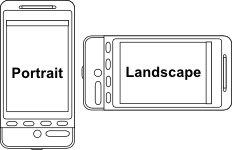Example List of Android Device Screens and Their Sizes
(Hardware has moved on. This article is now archived. For the screen sizes of the latest phones see GSMArena.)
The success of Android as a mobile device Operating System (OS) has resulted in a large variety of screen sizes and resolutions. Here is a list of example devices to show that variation.

In the following table it is assumed that the device is held in portrait orientation. As such the width in pixels is the X-axis and the length or height in pixels is the Y-axis. Obviously that swaps when the device is held in landscape orientation. Android has support for both orientations so that a correctly programmed appp will work no matter which way you hold the device. If you need to understand about pixels see the article How Computer Screens and Printers Show Images. The total number of pixels in a screen is the number in the x-axis multiplied by the number in the y-axis. The more pixels for each square inch (or centimetre) of display the sharper any images will be displayed (provided those images are at a high resolution).

For an explanation of the Acronym see the article Screen Resolution Names. The Size column next to each device is the diagonal measurement for the device screen in inches. This table illustrates that screens with the same resolution can be different sizes.
List of Example Andriod Screen Sizes and Resolutions
| # Pixels | X | Y | Acronym | Device Example 1 | Size | Device Example 2 | Size |
|---|---|---|---|---|---|---|---|
| 76800 | 240 | 320 | QVGA | ZTE Tureis | 2.6 | Samsung Galaxy Fit (GT-S5670 ) | 3.3 |
| 96000 | 240 | 400 | WQVGA400 | Samsung Galaxy Apollo | 3.2 | Archos 32 Internet Tablet | 3.2 |
| 153600 | 320 | 480 | HVGA | HTC ChaCha | 2.6 | HTC Explorer | 3.2 |
| 230400 | 360 | 640 | nHD | Dell Aero | 3.5 | Dell Mini 3ix | 3.5 |
| 307200 | 480 | 640 | VGA | Motorola Pro+ MB632 | 3.1 | Motorola Admiral | 3.1 |
| 384000 | 480 | 800 | WVGA800 | Google Nexus One | 3.7 | Dell Streak 7 | 7 |
| 409920 | 480 | 854 | WVGA854 | Sony Xperia Ray | 3.3 | Archos 43 Internet Tablet | 4.3 |
| 480000 | 600 | 800 | SVGA | Elonex eTouch 702ET | 7 | Pandigital SuperNova | 8 |
| 491520 | 480 | 1024 | UWVGA | Acer Iconia Smart S300 | 4.8 | Sony Tablet P | 5.5 |
| 518400 | 540 | 960 | qHD | Motorola Atrix | 4 | HTC Vivid | 4.5 |
| 614400 | 640 | 960 | DVGA | Sharp IS03 | 3.5 | iPhone 4S | 3.5 |
| 614400 | 600 | 1024 | WSVGA | Amazon Kindle Fire | 7 | Archos 101 Internet Tablet | 10.1 |
| 786432 | 768 | 1024 | XGA | Archos 80 G9 | 8 | Malata T8 | 9.7 |
| 921600 | 720 | 1280 | WXGA720, HD, 720p | Galaxy Nexus (GT-i9250) | 4.6 | Sony Xperia S | 4.3 |
| 983040 | 768 | 1280 | WXGA | Ramos W15 | 8 | LG Optimus PAD (V900) | 8.9 |
| 1024000 | 800 | 1280 | WXGA800 | Samsung Galaxy Note (GT-N7000) | 5.3 | Motorola Xoom 2 | 10.1 |
The iPhone 4S is shown in the table for comparision purposes, see the DVGA line, it is not an Android phone. Note a Full High Definition (FHD) or 1080i/1080p screen is 1080×1920 which is 2,073,600 pixels. Despite the wide variation in resolutions and screen sizes the Android OS and its Software Development Kit (SDK) caters for all of them.
Archived Comments
Raviraj Sukhadiya on September 5, 2012 at 10:26 am said: Android Device information really useful for me. Thanx. All is well.
Marks Adwin on February 4, 2013 at 6:42 am said: I was searching for most used Android devices screen resolution for developing a new Android wallpaper website. Above information helped me a lot. Thanks a ton.
See Also
- For a full list of the articles available on Tek Eye see the full website Index.
Author:Daniel S. Fowler Published: Archived:







